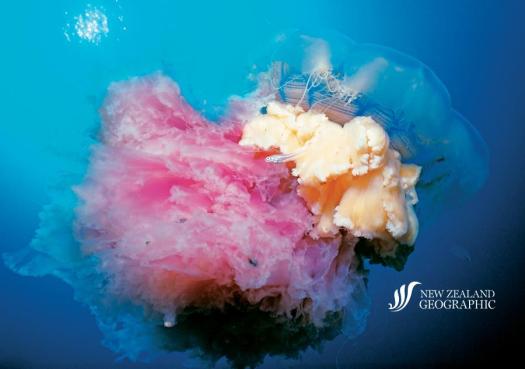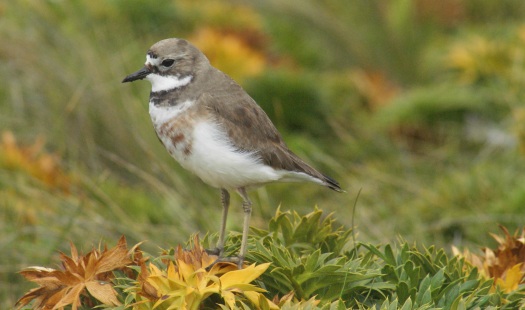I’m in the second year of my Masters degree now – and expected to write a thesis before the year is through. I’m writing it about Marine Metre Squared – a citizen science project that’s all about getting communities involved with marine biology. I have tried to find ways to tie that in with my interest in the Sub-Antarctic Islands and so when the picture below popped up on my Twitter feed, I was inspired to do some research on what one might find in the Southern Ocean surrounding the Sub-Antarctic Islands of New Zealand.
 “Playing host to larval fish at a depth of 24m off subantarctic Campbell island, a large Cyanae sp. looks like an exploded ball gown.” (Photo: New Zealand Geographic).
“Playing host to larval fish at a depth of 24m off subantarctic Campbell island, a large Cyanae sp. looks like an exploded ball gown.” (Photo: New Zealand Geographic).
New Zealand’s Sub-Antarctic Islands play a vital role in maintaining the ecological health of the Southern Ocean. Marine mammals and penguins rely on them to stop, rest and breed. But the ocean surrounding them is just as important – it feeds the wildlife that stops to populate the islands.
 The Light-mantled Sooty Albatross relies on the Southern Ocean for sustenance (Photo: Kimberley Collins).
The Light-mantled Sooty Albatross relies on the Southern Ocean for sustenance (Photo: Kimberley Collins).
We often think of the ocean as foreign – not many of us interact with it daily despite it being within reach for most New Zealanders. So how do we expect to experience what’s below the surface in the remote Sub-Antarctic Islands?
NIWA researchers have found that marine biodiversity and levels of endemism around the Auckland Islands, Campbell Island, the Bounty Islands, and the Antipodes Islands are higher than it was originally assumed. In April 2005, surveys of the subtidal ledges around the Bounty and Antipodes Islands drew comparisons to the biodiversity found in tropical and North Pacific environments. They suggested that Sub-Antarctic marine biodiversity was 25% higher than that in the Hauraki Gulf and 20 – 30% lower than that in Fiordland, which is renowned as one of the most biologically diverse areas in the world.
While the Southern Ocean is home to everything from plankton to cetaceans to fish – the first species I think of when someone mentions the region is bull kelp. It’s one of the more stunning sights surrounding the Snares and, as I recently wrote in a blog post for Marine Metre Squared, has some novel applications in New Zealand culture.
 Bull kelp (Photo: Froots).
Bull kelp (Photo: Froots).
 The Southern Blue Whiting (Micromesistius australis) that feeds the Campbell-Browed Albatross (Photo: United Fisheries).
The Southern Blue Whiting (Micromesistius australis) that feeds the Campbell-Browed Albatross (Photo: United Fisheries).And so it is no wonder that there have been calls from concerned citizens, scientists, and politicians to change the way the oceans around the islands are managed. The Sub-Antarctic Marine Reserves Bill had its final reading in parliament in late 2012, and proposes to create two more marine reserves around the Bounty Islands and Campbell Islands. They will cover 58% and 39% of those islands’ territorial ocean, effectively protecting a total of 435,163 hectares. When added to the marine reserve that already exists around the Auckland Islands, nearly a million hectares of ocean around the Sub-Antarctic Islands will be protected – which is great news for the birds, cetaceans (whales), and pinnipeds (seals) that rely on them.
What species do you know of that are found in the Sub-Antarctic marine environment?



 Campbell Island Teal (Photo: Kimberley Collins)
Campbell Island Teal (Photo: Kimberley Collins)




